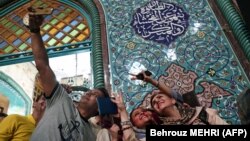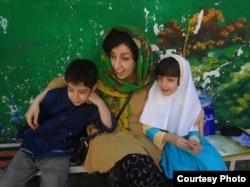Iranian voters and journalists, continue to depict the election day under different hashtags on social media. Although access to platforms such as Twitter and Facebook are still blocked, citizens use proxies to circumvent internet filtering.
During the election campaign candidates vigorously used different virtual platforms. Many pro-reformist strategists who would not have the possibility to use state TV for campaigning, took to social media and spoke to potential voters using InstagramLive and similar tools.
Here is a look at election day through the lens of twitter users in Iran and abroad:
Journalist Ershad Alijani posting this photo of the head of environmental protection agency Masoumeh Ebtekar and Former foreign minister Ebrahim Yazdi, highlighting their past. Ebtkar was among the students who took US diplomats as Hostage and Yazdi is a politician who is described here as Hostage of that action for the past 30 years.—he resigned from his position while opposing hostage taking. They both voted for Hassan Rouhani today
Since the 1979 revolution, millions of Iranians left the country and reside in different parts of the world. The first big exodus was right after the revolution, followed by the long Iran-Iraq war, which prompted many more Iranian to leave the country. After the disputed presidential election of 2009, a new generation of Iranians chose to migrate abroad. The result of these migrations, especially of younger people, is felt today at polling stations in different cities around the world. In Melbourne, Australia, polling stations extended the voting hours until 11 pm due to the high turnout.
Fridays are popular for celebrating a wedding. These newlyweds chose to turn up at polling stations before joining their party.
Amene Shirafkan a Journalist and candidate for Tehran City council, highlights the fact that Former president Mohammad Khatami is banned from appearing in public and the media are not allowed to publish his photos, but here as he voted this morning in Tehran, dozens of cameras recorded his appearance.
Here are the women at the notorious Evin prison in Tehran. The woman with green headscarf is supposedly Narges Mohmmadi, political activist sentenced to 10 years in prison. A few days ago, she announced that she will be casting her ballot and voting for the incumbent, Hassan Rouhani.
(here is an older picture of her with the same scarf)
Meanwhile one of the issues which has driven away many Iranian women from voting in elections outside the country, is the requirement of wearing the compulsory headscarf. In the past elections some showed up in front of polling stations without the headscarf as an act of protest. This year many women entered embassies and polling stations without observing the Islamic dress code and voted. This is the newly reopened Iranian Embassy in London, and the voter at the front is Hamid Baeidinejad, Iranian ambassador and former negotiator at Nuclear talks with world powers.
Ladane Nasseri of Bloomberg is among dozens of journalists from western outlets who is reporting from Tehran
Buzzfeed Journalist Borzou Daragahi follows the vote in Istanbul and reports of a high turn out of Iranians in Turkey.
And some Iranians and non-Iranians have been calling for a boycott of this election which they believe is not an election at all. WSJ's columnist Sohrab Ahmari writes Iranians humiliate themselves by participating in this election.
Cannes film Festival is under way, and two times Oscar winner Asghar Farhadi casts his ballot while attending the festival.
Back in Tehran the archbishop of the Armenian church also voted:
This User who is not voting, highlights the imprisonment of Atena Daemi who is reportedly on hunger strike since 40 days and hoping that her plight is not forgotten in the midst of the election hype.
Petroleum minister Bijan Zanganeh poses for a selfie with Mohsen Hashemi ( brother of later hashemi Rafsanjani) with a group of youth at polling station. Zanganeh says” it’s the selfies which remain”.
Thomas Erdbrink of New York Times is one of the few western journalists based in the country. He is tweeting from different parts of Tehran.
France 24 reporter, Sanam Shantyaei depicted "The cyclers' vote". These voter’s highlight a contentious subject of Rouhani's presidency: If women are to cycle on the street or not? Supreme Leader Khamenei opposed it, but women carried on. Tehran residents began to use bicycle more than ever, as they face suffocating air pollution in the city.
One picture raised eyebrows today. As Supreme Leader Khamenei voted, photographers noticed the stone of the ring, or more precisely the color of it. Purple is the color of Hassan Rouhani’s campaign. As some were speculating if this means Mr.Khamenei’s support for Rouhani, his office has reportedly denied the speculations. Pink ring stones are the favorite of the clergy.
And some continue to Vote as long as they can:







